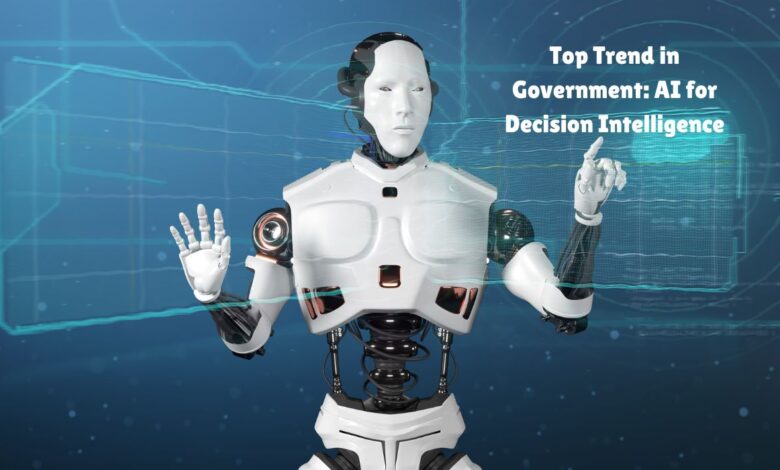Top Trend in Government: AI for Decision Intelligence
Explore the top government trend: AI for decision intelligence. Discover how artificial intelligence is shaping smarter governmental decision-making.

Artificial Intelligence (AI) is a branch of computer science that focuses on creating systems capable of performing tasks that typically require human intelligence. These tasks include problem-solving, learning, speech recognition, and decision-making. In recent years, AI has emerged as a crucial tool for the government sector, revolutionizing how various functions and services are delivered.
The growing importance of AI in government can be attributed to its ability to enhance efficiency and accuracy in processing information. Governments are frequently faced with vast amounts of data that need to be analyzed quickly and accurately. AI systems excel at handling these large datasets, uncovering patterns and insights that human analysts might miss or take longer to identify. This capability allows government agencies to make more informed decisions, thereby improving public services.
Another significant benefit of AI in government is its potential to streamline operations. By automating repetitive tasks, AI frees up human resources, enabling government employees to focus on more complex and strategic activities. For instance, AI can be used in administrative functions to handle routine inquiries or process applications, significantly reducing the time and effort required for these tasks.
Furthermore, AI contributes to enhancing the accuracy of governmental functions. In areas such as public safety, AI-powered systems can predict crime hotspots or natural disaster occurrences, allowing for better preparedness and response. In healthcare, AI helps in diagnosing diseases and optimizing treatment plans, ultimately improving public health outcomes.
In the context of decision intelligence, AI’s role becomes even more prominent. Decision intelligence refers to the application of AI to improve decision-making processes. By leveraging AI, governments can evaluate multiple scenarios and outcomes, leading to more robust and data-driven decisions. This ensures that policies and actions are more aligned with the needs and expectations of the public.
Overall, the integration of AI in government is not just a trend but a transformative shift that promises to enhance the efficiency, accuracy, and responsiveness of governmental operations, ultimately benefiting society at large.
What is Decision Intelligence?
Decision Intelligence is an interdisciplinary approach that combines elements of data science, social science, and managerial science to enhance decision-making processes. It leverages advanced data analytics, behavioral insights, and strategic management principles to create a cohesive framework for informed and effective decision-making. The integration of these diverse fields allows for a comprehensive understanding of complex scenarios, thereby facilitating more accurate predictions and better outcomes.
The significance of Decision Intelligence lies in its ability to transform raw data into actionable insights. By employing sophisticated algorithms and machine learning models, Decision Intelligence systems can identify patterns, forecast trends, and suggest optimal courses of action. This process is not just about crunching numbers; it also involves understanding human behavior and organizational dynamics to provide a holistic view of the problem at hand.
Artificial Intelligence (AI) plays a pivotal role in enhancing Decision Intelligence. AI technologies such as natural language processing, neural networks, and predictive analytics enable the automated analysis of vast datasets, uncovering insights that would be impossible for humans to discern manually. These AI-driven insights are crucial for making data-informed decisions, particularly in environments characterized by high levels of complexity and uncertainty.
In government settings, Decision Intelligence can be utilized in various ways to improve public administration and policy-making. For example, AI-driven predictive analytics can help government agencies anticipate and mitigate the impact of natural disasters, thereby enhancing public safety and resource allocation. Similarly, data-driven decision models can optimize the distribution of public funds, ensuring that resources are allocated efficiently and equitably. Another application is in public health, where Decision Intelligence can analyze epidemiological data to guide interventions and control outbreaks effectively.
Overall, Decision Intelligence represents a significant advancement in how decisions are made within governmental frameworks. By integrating AI technologies with traditional decision-making methodologies, it offers a powerful tool for enhancing the efficacy and responsiveness of public administration. This interdisciplinary approach not only improves the quality of decisions but also fosters transparency and accountability in governance.“`html
Key Benefits of AI for Decision Intelligence in Government
Integrating Artificial Intelligence (AI) into decision-making processes within the government offers numerous advantages that can significantly enhance operational efficiency and effectiveness. Below are some of the key benefits:
Improved Data Analysis: AI can process vast amounts of data quickly and accurately, providing governments with deeper insights. This capability allows for more informed decisions based on comprehensive data analysis, which can identify patterns and trends that might be missed by human analysts.
Faster Decision Making: AI’s ability to analyze data in real-time enables quicker decision-making processes. Governments can respond promptly to emerging situations, whether they involve public safety, health crises, or economic shifts. This agility is crucial in a rapidly changing world where timely decisions can make a significant difference.
Reduced Human Error: By leveraging AI, the risk of human error is minimized. AI systems are not prone to fatigue or biases, ensuring that decisions are made consistently and based on accurate data. This reliability is particularly important in critical areas such as public health, finance, and security.
Better Resource Allocation: AI can optimize the allocation of resources by analyzing data on needs, availability, and utilization. This ensures that resources are distributed more effectively, reducing waste and ensuring that critical areas receive the attention they need. For example, AI can help in the equitable distribution of public health resources during a pandemic.
These benefits highlight the transformative potential of AI for decision intelligence in government. By improving data analysis, accelerating decision-making, reducing errors, and optimizing resource allocation, AI can play a pivotal role in enhancing the efficiency and effectiveness of governmental operations.
Real-World Applications of AI in Government Decision-Making
Artificial Intelligence (AI) is revolutionizing how government agencies make decisions by enhancing efficiency, accuracy, and overall intelligence. This technology’s real-world applications span across various sectors, including public safety, healthcare, transportation, and policy making, demonstrating significant impacts on both the operational and strategic levels.
In the realm of public safety, AI has been instrumental in predictive policing. Law enforcement agencies utilize machine learning algorithms to analyze vast amounts of data and predict potential criminal activities. For instance, AI systems can process historical crime data, social media activity, and geospatial information to forecast hotspots for criminal activity. This enables law enforcement to allocate resources more effectively, potentially preventing crimes before they occur.
The healthcare sector also benefits immensely from AI. Governments are leveraging AI to improve patient outcomes and streamline healthcare services. For example, AI-driven predictive analytics can identify populations at risk for certain diseases, allowing for preemptive measures and early interventions. Additionally, AI systems can optimize hospital operations by predicting patient admission rates, which helps in managing bed occupancy and staff allocation more efficiently.
Transportation agencies are tapping into AI to enhance mobility and reduce congestion. AI-powered traffic management systems analyze real-time traffic data to optimize traffic light sequences, reducing waiting times and improving overall traffic flow. Moreover, AI aids in predictive maintenance of infrastructure by identifying potential failures in transportation networks before they lead to significant disruptions or accidents.
In policy making, AI assists government officials in analyzing large datasets to derive insights that inform public policy decisions. For instance, natural language processing (NLP) tools can sift through public comments on proposed regulations, providing policymakers with a nuanced understanding of public sentiment. This ensures that policies are more aligned with the needs and concerns of the populace.
These examples underscore the transformative impact of AI on government decision-making processes. By embracing AI, government agencies can enhance their decision intelligence, leading to more effective and responsive governance.
Challenges and Ethical Considerations
Implementing AI in government decision-making processes comes with a myriad of challenges and ethical considerations. One of the foremost concerns is data privacy. Government agencies handle sensitive information, and ensuring this data remains confidential is paramount. The risk of data breaches and unauthorized access could undermine public trust and have severe implications for national security. Therefore, robust data protection measures must be established to safeguard citizens’ personal information.
Another significant challenge is security. AI systems can be vulnerable to cyberattacks, which could manipulate outcomes or compromise the integrity of decision-making processes. Strengthening cybersecurity protocols and regularly updating AI systems to patch vulnerabilities are critical steps in mitigating these risks.
Bias in AI algorithms is an additional concern. AI systems learn from historical data, which may contain inherent biases. If unaddressed, these biases can lead to unfair and discriminatory outcomes that disproportionately affect certain groups. To ensure fairness, it is crucial to implement rigorous testing and validation procedures. This includes using diverse and representative datasets during the training phase and continually monitoring AI outputs for signs of bias.
Furthermore, the ethical use of AI in government necessitates a commitment to transparency. Citizens have a right to understand how AI systems are being used to make decisions that impact their lives. Clear communication and transparency about AI processes can help build public trust and ensure accountability. Governments should consider establishing oversight bodies to monitor AI applications and enforce ethical standards.
Lastly, maintaining fairness in AI-driven decisions is essential. Governments must adopt ethical guidelines and frameworks that promote equitable outcomes. This can be achieved by engaging with a broad range of stakeholders, including ethicists, technologists, and community representatives, to create policies that reflect societal values and priorities.
Addressing the challenges and ethical considerations in implementing AI for decision intelligence in government is imperative. By prioritizing data privacy, enhancing security, mitigating bias, ensuring transparency, and promoting fairness, governments can harness the potential of AI while upholding public trust and ethical standards.
- What is Trend Trading? And Trend Trading Strategies
- What is Trading and How does it Work?
- What Is the Stock Market, What Does It Do, and How Does It Work?
Steps for Implementing AI in Government
Implementing Artificial Intelligence (AI) for decision intelligence in government requires a structured and strategic approach to ensure effectiveness and sustainability. The following step-by-step guide outlines the essential phases government agencies should consider:
1. Identify the Right AI Technologies: The initial step involves assessing various AI technologies to determine which ones align best with the agency’s goals and objectives. This includes evaluating machine learning models, natural language processing tools, and predictive analytics platforms that can enhance decision-making processes.
2. Gather and Prepare Data: Data is the cornerstone of any AI initiative. Agencies need to collect relevant data from various sources and ensure it is accurate, complete, and unbiased. This involves cleaning, normalizing, and anonymizing data to maintain privacy and security standards.
3. Build a Skilled Team: Training staff is crucial for the successful implementation of AI. This involves hiring data scientists, AI specialists, and other technical experts, as well as providing ongoing training for existing employees to familiarize them with AI technologies and methodologies.
4. Develop and Test AI Models: Once the team is in place, the next step is to develop AI models tailored to the agency’s specific needs. This phase includes designing algorithms, training models with prepared data, and rigorously testing these models to ensure they produce accurate and reliable insights.
5. Implement AI Solutions: After successful testing, AI solutions can be integrated into the agency’s existing systems and workflows. This may require updating IT infrastructure, ensuring interoperability with existing software, and addressing any technical challenges that arise during implementation.
6. Continuous Monitoring and Evaluation: AI implementation is an ongoing process. Continuous monitoring and evaluation are necessary to assess the performance of AI systems, identify areas for improvement, and ensure the technology adapts to changing conditions and requirements. Regular audits and performance reviews help maintain the effectiveness and accuracy of AI-driven decision intelligence.
By following these steps, government agencies can effectively harness the power of AI to enhance decision intelligence, improve operational efficiency, and better serve the public.
Future Trends and Innovations
As artificial intelligence (AI) continues to evolve, its potential to revolutionize decision intelligence in the government sector grows exponentially. One of the most significant advancements on the horizon is the evolution of machine learning algorithms. Enhanced algorithms will allow for more accurate and nuanced data analysis, providing government agencies with deeper insights and more reliable predictions. This capability is particularly vital in areas such as public health, where timely and precise data can mean the difference between effective intervention and crisis.
Predictive analytics is another area poised for substantial growth. By leveraging vast amounts of historical and real-time data, predictive analytics can foresee trends and outcomes, enabling proactive decision-making. For instance, AI-driven predictive models could help urban planners anticipate population shifts, thus facilitating better resource allocation and infrastructure development. Similarly, law enforcement agencies could use these models to predict crime hotspots, allowing for more efficient deployment of resources and improved public safety.
AI-driven policy simulation is an emerging field with transformative potential. By simulating the impact of various policy decisions before they are implemented, governments can better understand the potential consequences and make more informed choices. These simulations can model complex scenarios involving economic, social, and environmental factors, providing a comprehensive view of the potential outcomes. This capability can lead to more balanced and effective policy-making, ultimately benefiting society as a whole.
Looking ahead, the integration of AI with other technologies such as blockchain and the Internet of Things (IoT) could further enhance decision intelligence. Blockchain can provide secure and transparent data management, while IoT can offer real-time data from a myriad of sources. Combining these technologies with AI can create a robust ecosystem for decision-making, enabling more responsive and efficient governmental operations.
Future of AI in government decision intelligence is promising. Continued advancements in machine learning, predictive analytics, and AI-driven policy simulation are set to significantly improve the efficiency, accuracy, and effectiveness of governmental operations, paving the way for a more informed and proactive public sector.
Conclusion
Integration of AI for decision intelligence represents a pivotal advancement in the realm of government operations. This blog post has delved into the transformative potential of AI in enhancing decision-making processes, improving efficiency, and fostering transparency within governmental agencies. By leveraging AI technologies, governments can analyze vast amounts of data with unprecedented speed and accuracy, leading to more informed and effective policy decisions.
The benefits of AI for decision intelligence in government are manifold. It enhances predictive capabilities, allowing for proactive measures in areas such as public safety, healthcare, and urban planning. AI also streamlines administrative tasks, reducing the burden on public servants and enabling them to focus on more strategic initiatives. Moreover, the use of AI can bolster public trust by providing data-driven insights that support transparent and accountable governance.
As AI continues to evolve, it is crucial for government officials and stakeholders to stay informed about the latest advancements and consider how these technologies can be integrated into their own roles. Embracing AI-driven decision intelligence can significantly enhance the effectiveness and responsiveness of government operations.



